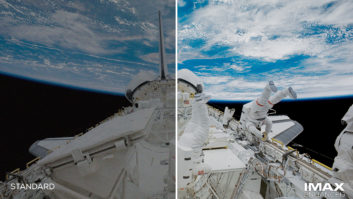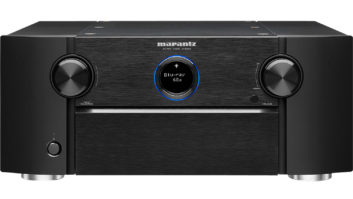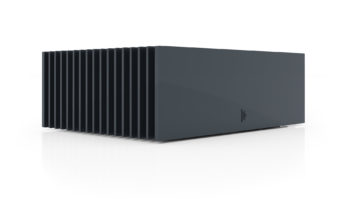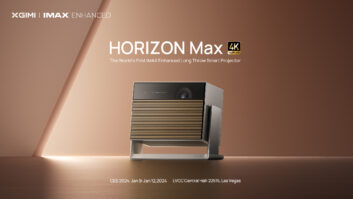One of the announcements at this past CEDIA was a new IMAX Enhanced certification program with the goal of elevating the home viewing standard. On December 4, I hosted a discussion on IMAX Enhanced with a panel of in-the-know professionals that included Phillip Jones, director of training, Sound United; Rob Brennan, training manager, home entertainment and sound, Sony Electronics Inc.; John McDaniel, vice president, business development, ecosystems; Xperi Corporation; and Bruce Markoe, senior vice president, head of post-production, DMR and operations, IMAX Corporation. (You can hear the full, one-hour discussion here.)

One of the announcements during the panel was the availability of the first two IMAX Enhanced certified Ultra HD Blu-ray discs, the IMAX documentaries, A Beautiful Planet, and Journey to the South Pacific. IMAX sent me a review copy of Journey and since I own the AV8805, one of the currently IMAX Enhanced-certified Marantz processors, I gave the disc a spin to see how it looks and sounds.
It was mentioned during the webinar discussion that IMAX Enhanced discs will play correctly on any Ultra HD Blu-ray player, and I can attest that this disc definitely works on the Xbox One S, the Samsung UBD-M8500, and the Sony UBP-X800.
Once playing, the DTS:X audio track on the disc immediately triggered my Marantz into a new sound mode labeled “IMAX DTS:X.” This appears to be a 7.1 core, which then triggers the Front and Rear Height speakers. Non-certified AVRs/processors will just play the normal DTS:X track. (Currently, certified displays do NOT go into any special IMAX mode. I watched the disc on two certified displays, the Sony XBR65X900F TV and VPL-VW285ES projector.)
According to a DTS press release, “IMAX and DTS have also partnered with award-winning Hollywood sound mixers to use a special variant of the DTS:X codec technology integrated in home audio equipment to deliver an IMAX signature sound experience with more immersive, powerful sound.” When IMAX DTS:X processing is engaged, the AVR automatically makes adjustments to audio settings such as bass management, LFE, crossovers, and levels to maximize the presentation. (You cannot actually see what adjustments have been made.)
I found dialog from the center channel to be quite “chesty” with IMAX DTS engaged. Journey is narrated by Cate Blanchette, and her voice is quite deep and forward and sonorous. The sound is designed to replicate the full dynamic range sound mix as found in the theatrical release, which features an 11.0, full-range channel layout. While I never saw this in an IMAX theater, I would say the audio achieves the goal of replicating the large, theatrical full-range sound. When I listened to the disc on a non-IMAX capable receiver, her voice definitely didn’t have the same weight to it. (Admittedly, this was in a different room with a different set of speakers.)
The audio mix is quite immersive, with lots of jungle ambient sounds mixed into the height speakers, along with the sounds of plunging water and bubbles as the action goes underwater. The height speakers are also used extensively for the film’s musical score. As it’s a documentary, don’t expect a ton of bass info, but the sub is used to add gravitas when needed.
Picture wise, this disc is stunning and reference quality in virtually every way. IMAX remasters movies using a tool called Digital Media Remasters (DMR), which uses noise reduction to optimize films for playback on the massive IMAX screens. This tool is also beneficial for reducing grain and noise for playback on modern 4K HDR TVs. The picture is razor sharp and incredibly clear, with amazing dimensionality. You can appreciate and see every pixel of detail, and this will make your 4K HDR display look as good as you’ve seen. Colors are vibrant with incredible pop and detail, and the underwater scenes are especially spectacular.
I say the picture was referent in virtually every way, as I noticed a couple of small quirks.
During the opening of the film (around 1 minute 20 seconds), there are a group of angel fish swimming. The fish in the background periodically have this weird motion distortion that, once noticed, is impossible to unsee. I saw this on three different displays, using two different players and two discs. No combination of motion adjustment settings seemed to correct this issue, and, as it just occurs with certain fish in the background, I can’t explain what causes it. Fortunately, the scene doesn’t last long and is really prior to the film’s start.
The second issue I noticed was some minor color banding. This was noticeable because I don’t believe I’ve seen any banding on a 4K disc up till now. The banding was not significant, and really only evident during underwater scenes where there are transitions from different shades of blue with the sun hitting the water. The banding was most noticeable during the whale shark scene near the end, and likely wouldn’t be something a typical viewer would catch. The banding was most noticeable on the projector, and least on the 900F.
This disc reportedly uses the new HDR10+ high dynamic range profile, but I was unable to test that as I don’t have access to a 10+ display. It’s worth noting that HDR10+ is fully backwards compatible with HDR10, which is supported by every manufacturer.
For a showroom demo, this is impressive content, and has me very excited for the first theatrical certified release…whichever that will be!
For more information about the IMAX Enhanced program you can visit IMAXenhanced.com.







